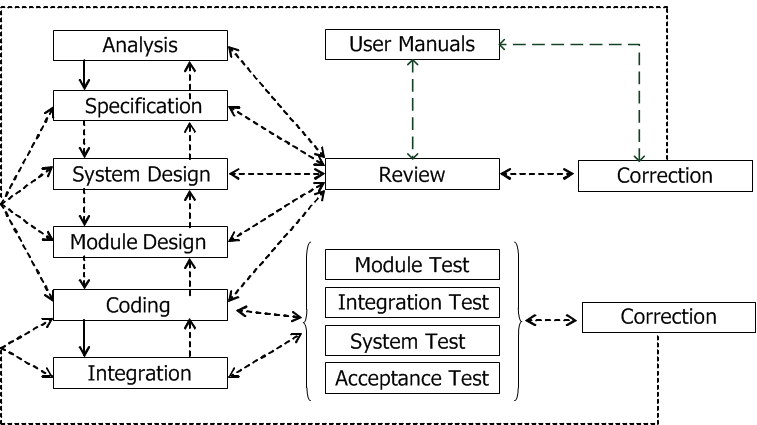The QA - Model: Difference between revisions
No edit summary |
No edit summary |
||
| Line 3: | Line 3: | ||
The '''QA - Model''' is the first fully developed model | The '''QA - Model''' is the first and fully developed model that is used for SESAM simulation runs. The model focuses on the development of software in small to medium sized projects. To be precise, it is primary focused on quality assurance measurements and therefore the model is called Quality Assurance - Model (QA - Model). | ||
From trainees, the QA - Model requires proper staffing as well as the monitoring progress and quality control. Thereby, analysis, the specification, the system and module design, code, and the manual as well as the integration and delivery of the system have to be performed. In addition, all documents have to be reviewed and corrected. Also, module, integration, system and acceptance tests have to be performed. Trainees are also responsible for hiring employees, assigning tasks to them, and releasing them back into the pool of developers. | |||
{| style="width:100%;background:#FFFFCA;padding:0.5em" | | {| style="width:100%;background:#FFFFCA;padding:0.5em" | | ||
|- | |- | ||
| All of this | | All of this has to be done on time and within the budget! | ||
|} | |} | ||
===Waterfall Model=== | ===Waterfall Model=== | ||
The [[Waterfall Model]] was chosen and has been extended by additional structural and analytical measures. The model leaves it to the trainees to decide in which '''order''' they perform the various activities. Possible | The [[Waterfall Model]] was chosen and has been extended by additional structural and analytical measures. The model leaves it up to the trainees to decide in which '''order''' they perform the various activities. Possible phases in the QA - Model are shown in the following figure: | ||
| Line 21: | Line 22: | ||
The dashed arrows between the activities indicate that trainees do not have to act according to the waterfall model. While there is a predefined sequence between the phases, the trainees are not forced to | The dashed arrows between the activities indicate that trainees do not have to act according to the waterfall model. While there is a predefined sequence between the phases, the trainees are not forced to follow them at all. | ||
===Code-and-Fix Approach=== | ===Code-and-Fix Approach=== | ||
A code-and-fix approach is possible; however, the trainees are at least forced to create an '''Analyzing Document ''' and to do the '''Implementation '''. All other phases (between analysis and implementation) can be skipped. Thus, trainees are not retained from trying out the Code-and-Fix approach. | |||
Furthermore '''Rollbacks''' to previous phases are possible, as long as the | Furthermore '''Rollbacks''' to previous phases are possible, as long as the document created in that phase, still contains some errors which are not corrected. | ||
{| style="width:100%;background:#FFFFCA;padding:0.5em" | | {| style="width:100%;background:#FFFFCA;padding:0.5em" | | ||
|- | |- | ||
| Documents | | Documents can be checked and corrected as often as necessary! | ||
|} | |} | ||
It is important that the correction | It is important to note that the correction after a review has to be successfully completed before starting a new review. After correcting the document, all other activities can be executed in the usual manner. | ||
Latest revision as of 14:36, 16 May 2013
The QA - Model is the first and fully developed model that is used for SESAM simulation runs. The model focuses on the development of software in small to medium sized projects. To be precise, it is primary focused on quality assurance measurements and therefore the model is called Quality Assurance - Model (QA - Model).
From trainees, the QA - Model requires proper staffing as well as the monitoring progress and quality control. Thereby, analysis, the specification, the system and module design, code, and the manual as well as the integration and delivery of the system have to be performed. In addition, all documents have to be reviewed and corrected. Also, module, integration, system and acceptance tests have to be performed. Trainees are also responsible for hiring employees, assigning tasks to them, and releasing them back into the pool of developers.
| All of this has to be done on time and within the budget! |
Waterfall Model
The Waterfall Model was chosen and has been extended by additional structural and analytical measures. The model leaves it up to the trainees to decide in which order they perform the various activities. Possible phases in the QA - Model are shown in the following figure:

The dashed arrows between the activities indicate that trainees do not have to act according to the waterfall model. While there is a predefined sequence between the phases, the trainees are not forced to follow them at all.
Code-and-Fix Approach
A code-and-fix approach is possible; however, the trainees are at least forced to create an Analyzing Document and to do the Implementation . All other phases (between analysis and implementation) can be skipped. Thus, trainees are not retained from trying out the Code-and-Fix approach.
Furthermore Rollbacks to previous phases are possible, as long as the document created in that phase, still contains some errors which are not corrected.
| Documents can be checked and corrected as often as necessary! |
It is important to note that the correction after a review has to be successfully completed before starting a new review. After correcting the document, all other activities can be executed in the usual manner.